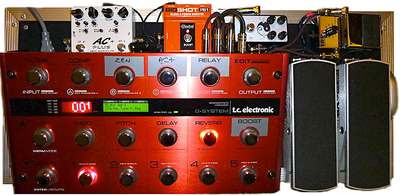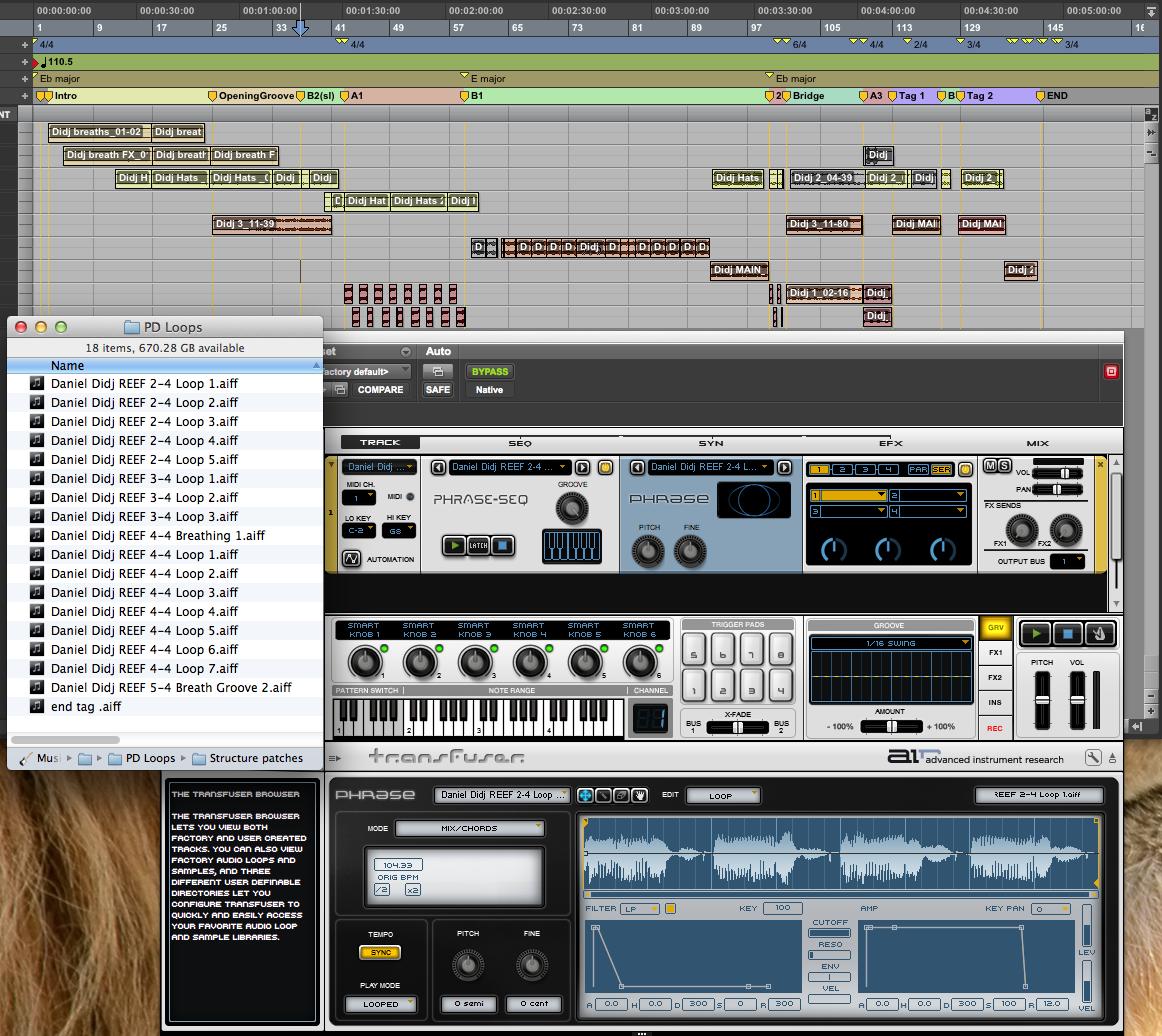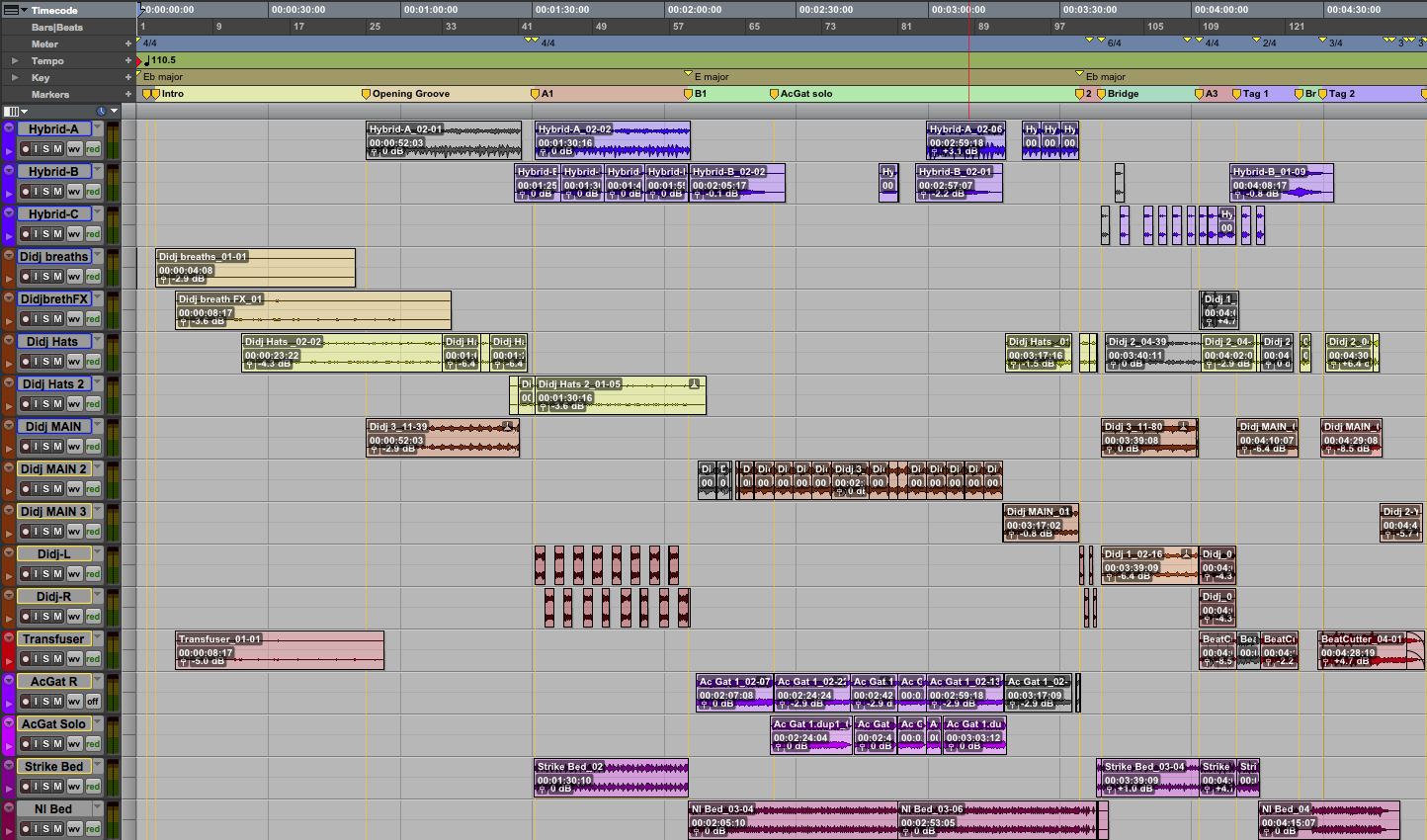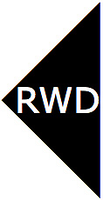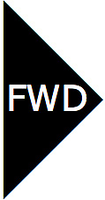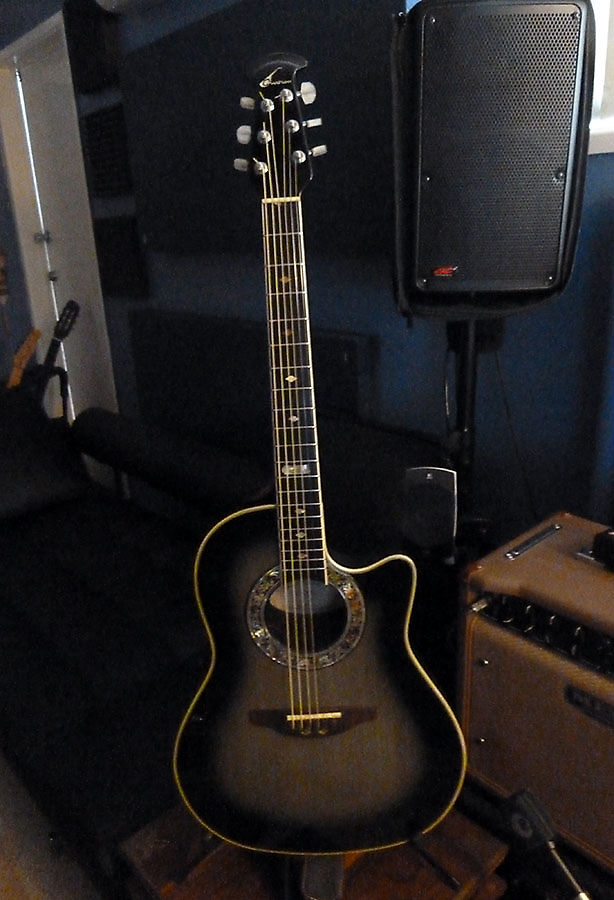3. ‘Over the Reef (Transfuser remix)’ analysis
This final piece in the exposition had the least direct input from other musicians. Daniel played on the original didj recording and I performed all of the rest, including, drums, guitars, synthesisers and some other newer technologies (for me).
I examined Daniel’s new piece and while it had many of the characteristics of his earlier work, there were also new features, especially in relation to the more overt use of DSP in the latter parts of the recording. This includes some interesting, often extreme uses of equalisation, distortion, digital delays and other recording studio processing.
Here I began to focus on the repetitive nature of the various pulsing figures, the fixed tonal centre (Eb), along with a sensibility of how the piece moved from ‘pulse’ to ‘pulse’ and introduced improvisational variations along the way, both through technique and technology. What became apparent to me was in fact that each of the essential ideas might be used in a DAW as audio loops to ‘perform’ (or re-mix) these in the same sequence that he had, but rather though cut and paste than ‘blow by blow’. This approach is not at all that unusual in the dance music and DJ world, but was a operational genre that until this point was not especially interested in nor familiar with.
I turned to one of Pro Tools ‘virtual instruments’, intriguingly named Transfuser. After a little work with the manual but particularly Internet blogs, it would seem this was an ideal tool for what I had in mind. What I wanted to avoid was the multi-tempo mapping drudgery from before, but mostly, this piece really did seem to break down into a finite collection of shorter, essential elements that could be ‘looped’ out into longer arrangements – either to replicate his original performance lengths for each of these ostinato pulses, or to freely re-arrange or extend as the work might take me. This proved relatively straightforward, and all of the relevant material was marked up and divided into their essential essence as short sections of no more than four bars each. Each of these loops then were loaded into Transfuser and part of its magic was that it could i) synchronise and pitch/time shift as required with reference to the parent DAW and the tempo /bar line I might choose, and ii) that it could then easily ‘fly’ these parts into the DAW tracks as required, in fact reassembling his work, but now in tempo and locked to ‘smart’ DAW editing possibilities.
My first arrangement simply recreated Daniel’s original sequencing through this method, and overall, was a much more rapid, uncomplicated and technically satisfying process that the earlier beat mapping exercises with Logic Pro in Pulse Two (remix). In terms of artistic satisfaction, I did have some initial concerns as to how Daniel might respond to this kind of intrusion, or if the fixed tempo and repetitions might degrade the music in other unforeseen ways. Nonetheless, ‘flow state’ was overpowering and the piece moved on as I quickly discovered, interacted with and began to improvise on Transfuser as a musical instrument. Another notable impact here was in that one of its features could ‘slice and dice’ audio material (also commonly used for dance music ‘beats’). When I began to explore its use by loading in didj parts, all kinds of possibilities quickly emerged, in sync with the timeline, and fluid in how they could be manipulated and placed. This then led to the only real extension of the horizontal arrangement for this piece: using only Daniel’s sounds, the opening breath sections were processed and layered to create an extended introduction up to 1:18 of the timeline. The ‘slicing’ and enhanced rhythmical elements are also most apparent here.
Later in the track I wanted to introduce an acoustic guitar, aiming that this might provide a better foil or contrast to the didj, vs. the more dominant distorted electric guitar I’d used earlier on Pulse Two (remix) 15. To do so, I wanted expansive chords on the guitar and so I easily pitch-shifted the didj up to E in the middle of the piece, again using Transfuser’s purpose designed capabilities. Aside from this, the primary emphasis for the rest of the piece was in trying to focus on Daniel’s original ideas and to draw out, enhance and respond directly to these via the arrangement. This only includes the way the guitars and synthesisers were voiced and arranged, but especially in the use of drums (or more accurately, my ‘drum programming’). Another new technical object to the fore, Native Instruments Kontakt and its library of drum sounds, tunings, patterns and mixes were used to quickly accomplish this, where the rhythms closely interplay with all of Daniel’s phrasing ideas16. This is especially evident on the closing sections of the piece. The very last ‘explosion’ from Daniel is exaggerated by slowing this down and extending its length, by once again, using Transfuser.
Synopsis and self-review (3):
No one seemed to notice the fixed tempo throughout, the ‘dance music’ approach I had been concerned about. The track also was the most quickly realised of all the 12 works I had created during this period, yet it would seem to suffer little by comparison to others, indeed, it has a certain freshness and dynamic about it that I find pleasing17. To my great pleasure – and despite my rather ‘old school’ misgivings about chopping up Daniel’s music in this way – he wrote back to me with great enthusiasm for the piece, and asking permission to distribute further though his website and other networks. Clearly, he had found this just as musical as his original work, despite the rather extreme use of sampling technology to slice, dice, loop and rearrange his original improvised performances.
Upon reflection, this wasn’t especially intentional and many other works were still in circulation. This streamlining of inputs in fact was directly a result of the quickened pace at which the piece proceeded, along with now clearly coalescing and positively impacting factors.
- I was now working in my studio some 12 hours per day, seven days a week. Perhaps to some degree informed by the knowledge that my sabbatical would be soon ending, but this was something that was certainly not a conscious driver, nor was any sense of urgency felt. Rather, I was in fact, increasingly ‘charged’ and much less tired by the work than I had been when I first began the project. I wrote notes about this at the time, shared ideas with my partner and friends and overall tried to make sense of it more when I was ‘out of the room’. When in the studio, time simply disappeared, but not with the old ‘slog’, rather, with the sense of extended flow that I recall from my best experiences with live performance and improvisation.
- I had long been aware of the fascinating work of Mihaly Csíkszentmihályi (1996), also given how many academic colleagues and students around me perceive and utilise his theories in terms of music-making. Elite musical performance is highly demanding, both mentally and physically, and in recent times the unlikely partners of sports sciences faculties and conservatories share common interests, research and pedagogies that work out of flow theory14 (for example, Rhythm & Flow Initiative, 2007). In brief: if the mind and body ‘flows’, so too does the music. From my perspective, I had always associated this with a somewhat magical place in musical improvisation, the jazz ‘solo-ing’ ethos, heightened musical instincts, hearing and reacting, times when the creative flow seemed totally unrestricted. In other research I was also drawn to the work of Guy Claxton (1997) (popular with teachers) who explores some of the same matters from a Buddhist perspective, but which focuses on the unconscious or what he terms ‘the undermind’. On the guitar then, I would try to practice well in formal, regular ‘chop-building’ sessions, then later ‘play’ with a view to not thinking at all about the technique, but to simply ‘speak’ the music with an expanding vocabulary developed through practice. This basic approach would be little different for most musicians.
- In closing stages of this project, I vividly recall many occasions when I came upstairs for dinner and yet once again commented that I believed that I was now experiencing the longest and most extended flow states I can recall across my entire musical career. Even if slightly flushed or overstated given minor wins on that particular day, these became constant realisations. More notably for me, there increasingly became no delineation between what I’d formerly considered as ‘practice’ vs. ‘performance’ states. The PDF manuals stayed open, the web browser connected, just as were so my guitars, DAW and recording devices. Where ‘technical objects’ had earlier taken over and came to the fore as problems needed to be resolved / practice needed to be done, where ‘epistemic things’ indeed did change shape and relevance depending on the needs of the day – now there appeared to be no boundaries between either and all seemed to exist in one ‘flow state’ within this artist’s studio.
15. Aside from the sonic considerations, I also wanted a good reason to incorporate one of my oldest and most treasured instruments: a 1984 Ovation signature that I had bought new in Singapore, and has been with me ever since in many situations, from the most casual strumming to the most career important engagements. Somehow, it seemed appropriate to ‘wrap up’ with this one.
17. I am less pleased about my sound production work and the inherent limitations of home studio facilities. These are matters for future improvement, and I believe that many other musical interests and opportunities will be bought to bear on this.
14. In my recent visit to the UK I was stunned in a tour of the still-under-construction new building for the Guildhall School of Music and Drama. A large area under the main stage was reserved a well equipped gym, plans for which included highly specialized training and preparation for the physical demands of various instruments on performers.
